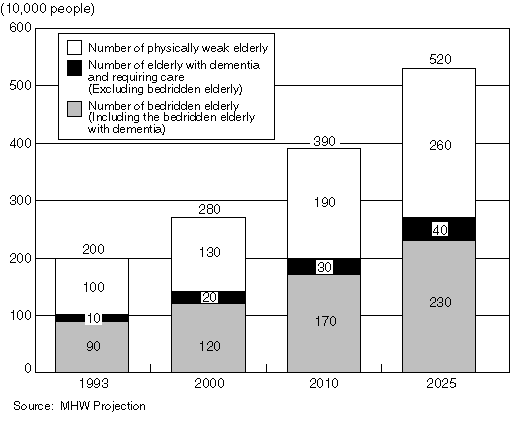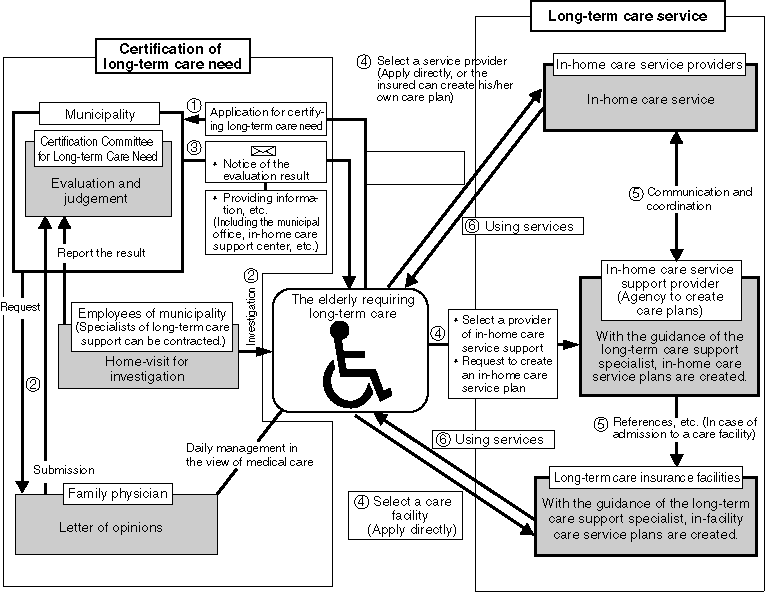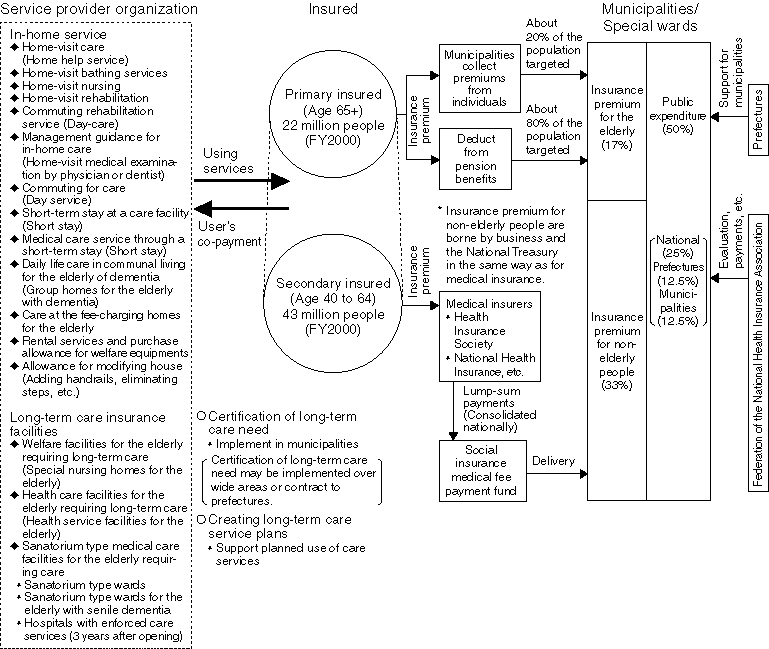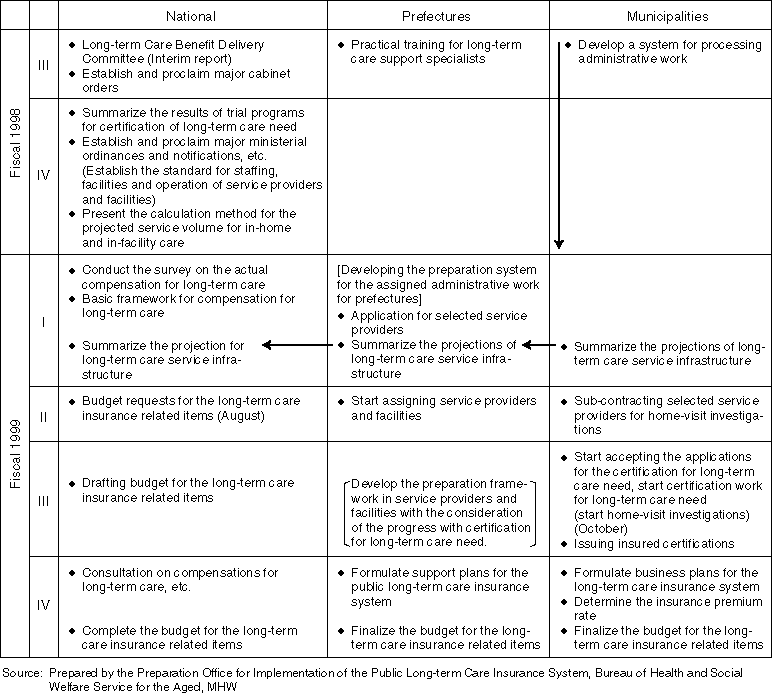
(1) Conditions surrounding the care for the elderly
After the war the average life expectancy in Japan has been extended remarkably with the improved environment for living and the advancement of medicine. In 1997 the average life expectancy reached 77.19 years for men and 83.82 years for women, and Japan became a longest-lived society in the world.
On the other hand, the rapid increase of elderly people who require long-term care for bedridden condition or dementia is projected along with the progress of aging society. Considering this situation, families providing long-term care are bearing heavy burden physically and psychologically, and that is causing the "care-worn" to the families and destroying the relationship among family members.
Figure 2-1-1. Future Projection of Elderly People in the Condition of Bedridden, Dementia and Physically Weak

(2) Aim of the establishment of the long-term care insurance system
The long-term care insurance system was established while the long-term care for the elderly was becoming a serious issue. It is intended to provide social support to long-term care for the elderly and to enable elderly people to maintain their human dignity through the end of their lives by carrying on self-sufficient living in the condition in which they require long-term care.
(3) Overview of the long-term care insurance system
Figure 2-1-2. Certification of Long-Term Care Need and the Procedure for Using Services

Figure 2-1-3. Overview of the Long-Term Care Insurance System

2. Smooth Implementation of the Long-Term Care Insurance System
The long-term care insurance system is scheduled to commence in April 2000, and the central government, prefectures and municipalities are working together to prepare for smooth implementation of the system in various aspects.
(1) Development of the infrastructure for long-term care services
As we develop the system to provide long-term care services, it is critically important to ensure that services are sufficient to meet demand and to avoid a situation where "insurance is available but not the service."
To prepare proper services, we must focus on the achievement of the goals set in the New Ten-Year Strategy to Promote Health Care and Welfare for the Elderly (The New Gold Plan). After the introduction of the long-term care insurance system, business plan for the long-term care insurance will be created based on the understanding of actual conditions of people requiring care in individual municipalities and projecting the required volume of long-term care services for the future, and also necessary support will be prepared at the national level.
(2) Implementation of certification for long-term care need
In order to receive services from the long-term care insurance, the insured must be certified as being in the condition requiring services due to bedridden or dementia (certification for long-term care need or support need), and for the stable operation of the long-term care insurance system, an impartial and fair process is required for the certification.
Since fiscal 1996, some trial programs have been implemented for the certification for long-term care need, and in fiscal 1998 the trial was conducted for all municipalities. Based on the result of these programs, the standard for certification for long-term care need was revised as necessary and then proclaimed.
(3) Establishment of cabinet orders and ministerial ordinances
For the smooth progress of the preparation efforts in prefectures and municipalities, the Long-Term Care Insurance Law Enforcement Order and the cabinet orders on the calculations of National Treasure's cost sharing for the long-term care insurance were established in December 1998, and in March 1999 ministerial ordinances and notifications were formulated to stipulate the criteria for selecting service providers, etc.
For the notification to stipulate service fees for long-term care in fiscal 2000 budget, we will propel the effort while properly offering necessary information to prefectures and municipalities.
(4) Support for municipalities financially and in the implementation system
The long-term care insurance system is structured with municipalities to be the insurer and the national government, prefectures, medical care insurers, etc. to provide multi-layers of support, so that the municipalities can receive various support to prevent excessive burden of administrative work or financial needs.
To provide financial and implementation system-wise support to municipalities for their smooth preparation work, \19.1 billion was budgeted for fiscal 1999 for various preparation cost for municipalities including the certification work for long-term care need, which will commence in October 1999, and \0.5 billion for the preparation cost for prefectures to conduct training to examiners and committee members for the certification for long-term care need, etc.
(5) Preparation efforts for the implementation at municipalities and prefectures
Prior to the implementation of the public long-term care insurance system, individual municipalities and prefectures will formulate municipal business plan for the long-term care insurance and prefectural support plan for the long-term care insurance in accordance with the basic guidelines provided by the national government.
The business plan for the long-term care insurance is to determine the goals for the services provided by the long-term care insurance of individual municipalities so that the necessary services are available to the insured, and in order for municipalities to achieve their goals, prefectures formulate support plans for the long-term care insurance to determine the necessary items to support in order to succeed the smooth delivery of insurance benefits for the operation and coordination of the admission capacities of care facilities in each wide area (areas determined by each prefecture).
In addition, each municipality will determine the insurance premiums for primary insured people within the responsible area based on the projected service volume in the municipal business plan for the long-term care insurance.
(6) Support for trans-regional efforts
Trans-regional approaches to administrative work for long-term care insurance are expected to bring the following benefits:
Because of these potential benefits, the national government budgeted \1.5 billion for the system cost for trans-regional cooperation in fiscal 1999 to support the trans-regional efforts.
Table 2-1-4. Preparation Schedule for the Implementation of the Long-Term Care Insurance System

(7) Training of long-term care support specialists (care managers)
For the training of long-term care support specialists (care managers) in fiscal 1998, about 90,000 people who passed the written examinations before attending practical training had just completed the practical training in each prefecture, and the training in fiscal 1999 is scheduled to begin with the written examination on July 25.